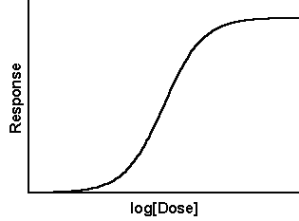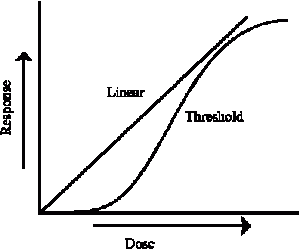It was interesting to see an article in The Guardian yesterday discussing dose response relationships and threshold doses. Generally, increasing the dose of a substance increases the severity of the effect it causes. Similarly, for a given effect, due to individual susceptibility increasing the dose leads to an increase in the response – i.e. the number of people affected. For most substances, however, there is a threshold dose – that is a dose below which no-one is affected. This is because at doses below he threshold, the body’s mechanisms can deal with the substance, preventing harm. This can be represented graphically.

Typical dose-response curve showing a "threshold dose" (source:http://www.unido.org/index.php?id=5297)
With some substances, such as carcinogens and sensitisers, it is not possible to detect a threshold experimentally. It is argued that this is because they do not have one . The response is still dependant on the dose and at very low doses there are still some people who will be affected, albeit a relatively small number. Nevertheless, there is no “safe dose”. In such cases the dose-response curve is likely to be linear.
The Guardian article discusses the views put forward by an Oxford University physicist, Wade Allison, who has published a book in which he argues that there is a threshold for the effects of ionising radiation. He contends that DNA damage caused by exposure below this threshold dose can be repaired by the cells natural processes. This goes against the established view that radiation, like other direct acting carcinogens, has a dose response curve which doesn’t have a threshold, so that there is no identifiable dose below which adverse effects do not occur. Other radiation specialists are quoted in the article who do not support his view.
The difficulty with carcinogens is that at low doses it isn’t possible to accurately determine whether there is an effect. Cancer can be caused by many agents, including some related to lifestyle (e.g. smoking) and natural sources (e.g. background radiation from cosmic radiation and from rocks) and in reality we are normally simultaneously exposed to multiple agents. At low doses a carcinogen, such as radiation, is only associated with very low incidences of the disease. So it can be difficult to determine exactly what is the causative agent. If there is a threshold, it is likely to be very low, and detecting it would be difficult.


No comments:
Post a Comment